page 5
(Using a philosophy of "threes" as a tool
for dissection and comparative analysis)
http://threesology.org
Anat., Bio. Phys. Researchers as of 3/17/2021
Pages in this series:
| 1 | 2 | 3 | 4 | 5 | 6 | 7 | 8 | 9 | 10 | 11 |
In order to develop a philosophy using "threes" as a tool for comparative analysis, it is necessary to note that many people don't. While they may have an interest in the number "3" as a favorite number, they have not made the transition to correlating the many three-patterned examples to be found in Anatomy, Biology, Physiology and multiple other subject areas. Not every... and perhaps not most instructors of anatomy teach their students about the "remarkable regularity" of threes as does Dr. McNulty in his List of Threes in human anatomy. In fact, in speaking with different health care professionals over the years, I have not yet found anyone familiar with the idea. The usage of "threes" as a tool of comparative analysis is typically reserved for correlating the presence of "three" in things like religion, mythology, superstitions, Astrology, Tarot card reading, witchcraft, Irish limericks and the like, though some numerologists may provide examples from subjects that don't include the sciences, music or mathematics as illustrated at this site: Mystical Numbers: The Number 3, even though it provides a good representative sampling from different perceptions that a reader may have encountered in their general perusal of different reading material in their respective cultural setting.
However, listing various examples of "threes"... or for that matter, ones (singularity, etc.), twos (duality, dimers, etc.), fours (quad-, etc.), fives (penta-, etc.), sixes, sevens, eights, nines, etc., regardless of the terms being used in a given subject area; it is not enough to just list them unless "one" (a person) is satisfied with the curiosity of the simple comparison. While I will admit that in my distant youthful years I was not only surprised but delighted to witness the presence of the "three" in different subjects, ultimately I came to ask why? And why wasn't there "threes" everywhere unless the non-three patterns had some importance as well.
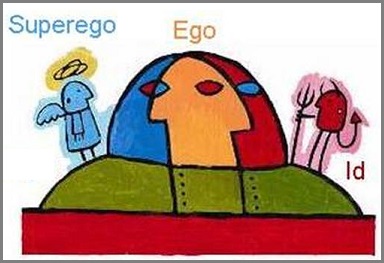
This then leads one into human cognition and psychology as part of a generalized anatomical, biological and physiological dissection which may occur with some psychiatrists, wherein I came across "threes" examples such as the Id-Ego-Superego and its Ego-centered corollary seen in the Child-Parent-Adult form of Transactional analysis, only to find that there is a old tradition of dissecting the human psyche and emotion into patterns-of-two such as the following list:
|
HISTORY AND SYSTEMS OF PSYCHOLOGY, DR. WARREN R. STREET
|
Let us add one "two" example to the list: Nature - Nurture, though the reader might think to add others.
While psychology students are being taught to look at the "whole" person with respect to anatomy, biology, and physiology as valid spectrums of human psychology, they are none-the-less introduced to an awareness of "twos" but not the very many "threes" of other available patterns, much less compare these in terms of adaptations responding to an incremental deterioration of the Sun-Earth-Moon triad, with respect to the Sun's energy depleting, the Earth's rotation is slowing (affecting the geo-magnetic-dynamo), and the Moon is receding (affecting the tidal "washing machine"); thereby detailing that the adaptive adjustments are physical, mental and emotional rationalizations used in an attempt to sustain some relative equilibrium.
While many a person excuses, explains or interprets a person's behavior according to age (youth, middle age, old age), and in so doing unconsciously take into consideration the presence of an ongoing anatomical, biological and physiological deterioration frequently referred to as "change, growth, maturity", etc., they are not placing the whole of the analysis into the context of the larger planetary deteriorations in which the presence of the many numerically identifiable patterns are not only occurring, but are representative of patterned processes most of us are oblivious to, and for which we humans have not designed instrumentation to help us in such an analysis, because most people are unaware of its existence... or are only aware of it is a superficial manner.
Most people appear to have an interest in pattern recognition for very selfish and superficial reasons that might be summed up in terms of enabling them to exploit one or more people and/or one or more situations. For example, they might think to themselves that such an endeavour as I and others are undertaking is not worthy of their time because it can't help them make a buck, or provide answers for a test, or manipulate someone into a sexual encounter. There only interest is a personal application of information without regard to any larger philosophically-based altruistic concerns for the all of life. In any respect, whatever a reader's motivation for reading the information at this site, they might just encourage another who will take a broader interest.
As for myself, because the recurrence of "threes" is a well-established fact, I take the time to find other patterns such as the three-to-one seen in the Mendelian ratio:
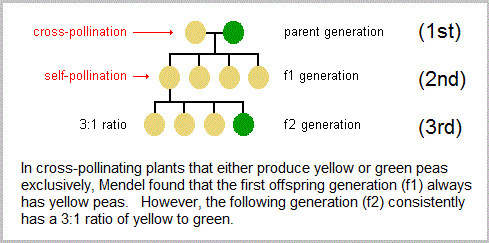
The Father of Genetics, by Sean D. Pitman M.D.
| A 3:1 Ratio is the relative fraction of
phenotypes
among progeny
(offspring) results following
mating between two
heterozygotes, where each
parent possesses one
dominant allele (e.g., A) and one
recessive allele (e.g., a)
at the genetic locus in question—the resulting progeny on average
consist of one AA genotype (A phenotype) for every one
aa genotype (a phenotype) for every two Aa
genotype (A phenotype), thus three A phenotypes for every one a phenotype. |
| A 9:3:3:1 Ratio is a
ratio of
phenotypes among offspring (progeny) that results when two
dihybrids mate, e.g., AaBa × AaBa, where
allele A is
dominant to allele a, allele B is dominant to
allele b, and the A and B
loci otherwise have no impact on each other
phenotypically (no
epistasis) nor genotypically (no linkage). |
With this pattern in mind, (and it must be on your mind in seeking other occurrences thereof), we find that a recognition thereof in other instances may require unconventional forms of perception. For example, when looking at DNA's so-called "triplet" coding system, the fact that both DNA and RNA utilize Adenosine-Cytosine-Guanine, leads many to overlook the presence of their constituent differences in that DNA has Thymine and RNA has Uracil. They are psychologically "dismissed" or overlooked because the idea of a 3-to-1 ratio does not come to mind. In effect, by looking at both DNA and RNA as comparative models, one may continue to view them as examples of a "three" occurrence, instead of recognizing the presence of a three-to-one ratio that is found in proteins as well. Interestingly, the description of DNA, RNA, and Proteins as "macromolecules", means there are three items under one heading:
| ~ Item ~ | ~ Three the same ~ | ~ One is different ~ |
| DNA = | Adenosine- Cytosine- Guanine | Thymine |
| RNA = | Uracil |
Yet, the "three the same, one is different" notion is not readily appreciated if we were to look separately at either DNA or RNA. Such an apparent distinction requires both to be placed side-by-side in order for us to make the comparison and highlight the existence of such a pattern. However, once the generalized idea of a "3 to 1" ratio is consciously affixed to our considerations, a list of other examples starts to gain application to various ideas that would otherwise suggest a pattern-of-four to an unsuspecting collector of diverse information, whether or not their research intent is to describe a recurrence that another prefers to use a numerical label in order to record the instance. The 3 to 1 ratio has thus become another cataloguing tool that is differentiated from and complementary to a strict "threes" formula.
And let us now add a simplified perspective of Protein structure (though there are others):
| Item | --- Three the same --- | --- One is different --- |
| Protein = | Primary- Secondary - Tertiary conformations | Quaternary as a composite of the first three |
| DNA | RNA | Proteins | |
|---|---|---|---|
| Encodes genetic information | Yes | Yes | No |
| Catalyzes biological reactions | No | Yes | Yes |
| Building blocks (type) | Nucleotides | Nucleotides | Amino acids |
| Building blocks (number) | 4 | 4 | 20 |
| Strandedness | Double | Single | Single |
| Structure | Double helix | Complex | Complex |
| Stability to degradation | High | Variable | Variable |
| Repair systems | Yes | No | No |
Because of the double-stranded nature of DNA, essentially all of the nucleotides take the form of Watson-Crick base pairs between nucleotides on the two complementary strands of the double-helix.
In contrast, both RNA and proteins are normally single-stranded. Therefore, they are not constrained by the regular geometry of the DNA double helix, and so fold into complex three-dimensional shapes dependent on their sequence. These different shapes are responsible for many of the common properties of RNA and proteins, including the formation of specific binding pockets, and the ability to catalyze biochemical reactions.
The architecture of proteins exhibits a 3-to-1 ratio, though many readers might prefer to see a transitional overlapping. In the present case, either the primary or quaternary structure may be viewed as the "odd man out", and even though some may prefer to look upon the primary and secondary configurations as a partnership due to simplicity, and the tertiary/quaternary impressions as expressions of complexity that belong together... whereby a 2 X 2 formula is viewed:
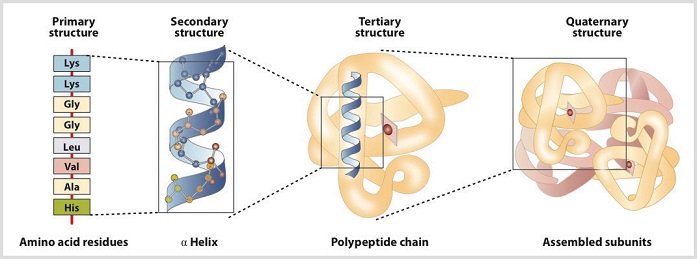
The Basics of General, Organic,and Biological Chemistry- section 18.4, Proteins
With respect to standedness, the conformation of proteins exhibits a three-to-one profile:
As an aside note, when we compare the usage of a coma in numbers to distinguish the separation between the hundreds and the thousands place in a series of numbers:
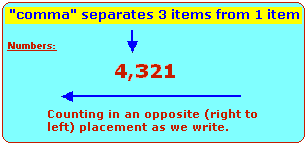
...with the "and" used as a separator such as in the case of Adenosine, Cytosine, Guanine "and" Uracil (or Thymine):
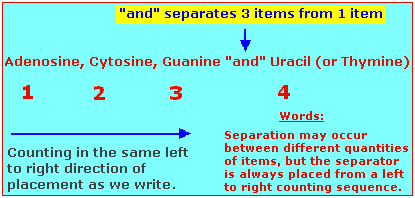
...the comma in the number grouping is placed in a from right to left sequence, while the "and" in the word grouping is placed in a from left to right sequence. This may suggest that the "right to left" usage in numbers had an early middle eastern (Arabic?) influence, (since both modern numbers and this method of writing had much of their influential beginnings in this area), but the "left to right" placement of a series separator in words did not have.
| 3 | 1 |
| 3 grouped (drumming) beats separated by | 1 emphasized beat (Native American) |
| 3 ordinary dimensions: Length ~ Width ~ Depth | 1 Time dimension |
| 3 fundamental gauge forces: Strong - Weak - Electromagnetic | 1 fundamental non-gauge force: Gravity |
| 3 "even" amino acids: Adenosine ~ Cytosine ~ Guanine | 1 "odd": Uracil (RNA), Thymine (DNA) |
| 3 basic protein structures: Primary - Secondary - Tertiary | 1 composite protein structure: Quaternary |
| 3 (metal) vending coins: Nickels ~ Dimes ~ Quarters | 1 relational (paper) form: Dollar bill |
| 3 numbered potatoes: 1 potato ~ 2 potato ~ 3 potato | 1 un-numbered 4 (counting game) |
| 3 numbered bits: 2 bits ~ 4 bits ~ 6 bits | 1 un-numbered: a dollar (cheer-leading) |
| 3 face cards: Kings ~ Queens ~ Jacks | 1 related Ace card (faceless) |
| 3 typically used face cards: Kings ~ Queens ~ Jacks | 1 less commonly used face card: Joker |
| 3 rhymes: eeny ~ meeny ~ miney separated by | 1 (mo) of another 3: (mo ~ toe ~ go) |
| 3 indoor coverings: Curtains ~ Blinds ~ Shades | 1 related outdoor: Shutters |
| 3 God labels: He ~ She ~ It | 1 relational: Non-Entity (non-existence) |
| 3 numbered bases: 1st ~ 2nd ~ 3rd related to | 1 unnumbered: Home plate/base |
| 3 customary years | 1 relational: leap year |
| 3 primary cycles: Intake ~ Compression ~ Power | 1 relational: Exhaust |
| 3 "element" A-U-M = "OM" |
1 relational: Silence |
| 3 step shampooing: Wet hair ~ Lather ~ Rinse | 1 relational: Repeat as desired |
| 3 female desires for a man: Tall ~ Dark ~ Handsome | 1 relational: Rich |
| NREM (non rapid eye movement)is divided into three stages | REM is usually referred to as a single phase (Despite the fact that a complex set of physiological fluctuations takes place in REM sleep.) |
| 3 part call: Hear Ye! Hear Ye! Hear Ye! | 1 relational: The court is now in session |
| 3 part game call: Apples ~ Peaches ~ Pumpkin Pie | 1 relational: Who's not ready hollar I |
| 3 basic forms of matter: Solids ~ Liquids ~ Gases |
1 relational: Plasma |
| 3 (metrical foot) stressed syllables | 1 relational unstressed syllable |
| 3 guitarists (Beatles): Paul ~ John ~ George | 1 relational drummer: Ringo |
| 3 regular U.S. forces: Army ~ Navy ~ Air force | 1 relational: Marines (Navy Dept.) [Coast Guard = Dept. of Transportation] |
| 3 times repeated cadence: Gimme' (give me) your left | 1 related: Right (military marching) |
| Gimme' your left- Gimme' your left- Gimme' your left----- Right | |
| 3 consonants to (four-letter) Cuss Words | 1 related vowel |
| 3 (numerical) feet: 1 foot + 1 foot + 1 foot equals | 1 related (word): Yard |
| 3 common body crossings: Legs ~ Arms ~ Fingers | 1 uncommon related: Eyes |
| 3 Europeans: D.L. George ~ V. Orlando ~ G. Clemenceau | 1 (U.S.A): W. Wilson (Paris Peace Talks) |
| 3 at-bat chances to run | 1 relational mandatory walk (ball four) |
| 3 microorganism "vats": Rumen ~ Reticulum ~ Omasum | 1 "true" stomach: Abomasum (Ruminants) |
| 3 Hurry! Hurry! Hurry! related to: | 1 Step Right Up (Circus Barker) |
| 3 synoptic gospels: Matthew - Mark - Luke | 1 idiosyncratic gospel: John |
| Trinitarian (3) concept related to | Unitarian (1) concept |
| 3 original musketeers (Athos, Porthos, Aramis) | 1 add-on (d'Artagnan) |
| 3 active brain waves (Alpha, Beta, Theta) | 1 inactive brain wave (Delta) |
| 3 types of cones to the human eye | 1 type of rod to the human eye |
| 3 Piaget operational stages: Pre - Concrete - Formal | 1 [non-operational] sensorimotor stage |
| 3 Basic gaseous biological compounds: |
1 Basic solid compound: |
| 3 rows of outer hair cells (mammalian ear) | 1 row of inner hair cells |
| 3 imagined places: Paradise - Purgatory - Inferno | 1 actual place: Earth |
| 3 common growing seasons: Spring - Summer - Fall | 1 less typical growing season: Winter |
| 3 metal ages: Silver - Bronze/Copper -
Iron [Bronze is an alloy of Copper] |
1 non-metal age: Stone (Was there a bone or stick age?) |
| 3 common alternate milk (with fat) forms: 1% - 2% - Skim | 1 common standard form: Whole milk |
| 3 interactive identities: i - j - k = | 1 resultant quaternion identity: -1 |
| W. Hamilton's quaternion formula: i2 = j2 = k2 = ijk = -1 | |
| 3 gasoline types: Unleaded - Regular - Premium | 1 Diesel fuel oil |
| 3 non-gasoline fuels: Diesel - Propane - Natural Gas | 1 gasoline fuels |
| 3 Earthly-bound Horsemen plagues: |
1 Heaven/Hell-bound Horsemen plague: |
| 3 (physically labeled) psychosexual stages: |
1 (non-physically labeled) stage: |
| 3 (OK Corral) Earp brothers: Wyatt - Morgan - Warren | 1 (OK Corral) Doc Holiday |
| 3 Stanley Miller Chemical Evolution experiment gases: |
1 Stanley Miller liquid: |
| Art Maxim Percentages division: |
|
| 3 basic tea types: Black - Green - Oolong | 1 (basic) rare tea type: White |
| 3 basic mathematical operations: |
1 auxiliary mathematical operation: |
| 3 (DNA) bases code for: | 1 amino acid |
| 3 customary laws of Thermodynamics | 1 Zeroth law of Thermodynamics |
| 3 types of bone: Cortical - Compact - Trabecular | 1 relational: Cartilage (pre-bone) |
| 3 U.S. Presidential debates (2004) | 1 relational: U.S. Vice President debate (2004) |
| 3 compulsory schools: Elementary - Jr. High - High school | 1 non-compulsory school: College (or Trade) |
| 3 "human" cartoon characters: Fred - Wilma - Pebbles | 1 animal character: Dino (family pet) |
| 3 "human" cartoon characters: Barney - Betty - Bam Bam | 1 animal character: Hoppy (family pet) |
| 3 "regular" corners to a building | 1 principal Corner Stone to a building |
| 3 foot bones of ancient horses | Fused together to make modern horse hoof |
| 3 at-base runners: 1st base - 2nd base - 3rd base | 1 at-home-plate grand slam hitter |
| 3 "traditional" size proportions: |
1 commercial profiteering size proportion: |
| 3 flexible downs in American football | 1 down to play it safe or risk it all |
| 3 word vulgar expression: God Damn It | 1 (3 into 1) single word vulgar expression: Goddamnit |
| 3 meal options: Sandwich - Side-order - Drink | called a (1) combo meal |
| 3 single letter blood type designations: A - B - O |
1 double letter blood type designation: AB |
| 3 phase (U.S.) electric service is related to | 1 phase (U.S.) electric service |
| Ones-Tens-Hundreds (followed by a comma that both separates and compartmentalizes this three) |
Whereby a "Thousands" place can be designated into a one-to-three formula: |
Let's talk peace page 14
When describing the triplet and three-to-one patterns in DNA and RNA, some readers may still argue that there are only two nucleic Acids. However, when comparing them, we frequently see that these two are portrayed in three-patterned illustrations like a three-part logical syllogism:
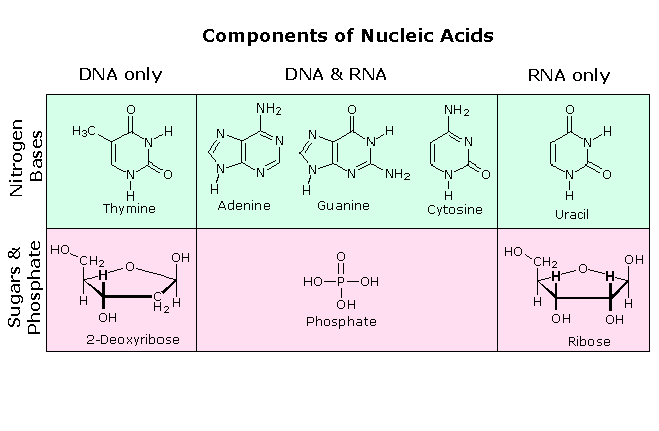
Nucleic Acids
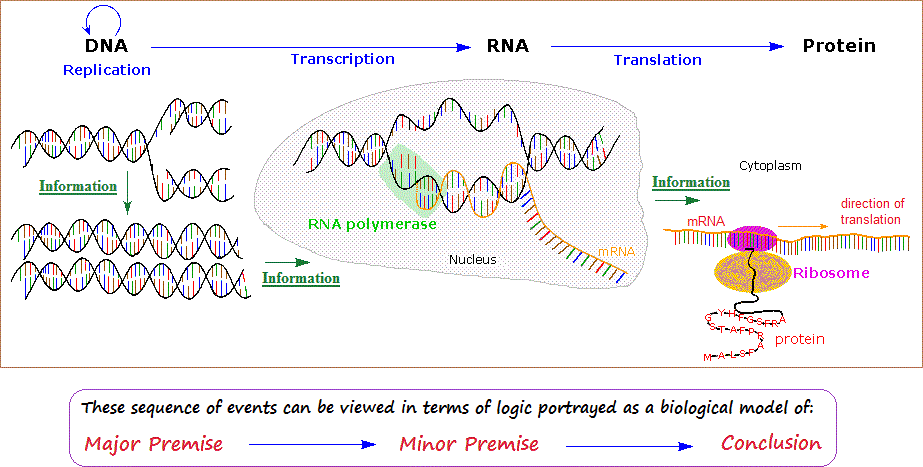
Nucleic Acids
Page initially created: Thursday, 10-August-2017... 4:49 AM
Initial Posting: Thursday, 07-Sept-2017... 5:18 PM
Updated Posting: Sunday, 13th-May-2018... 6:59AM
Most Recent update: Monday, 13th, March 2023... 10:59 PM
Herb O. Buckland
herbobuckland@hotmail.com